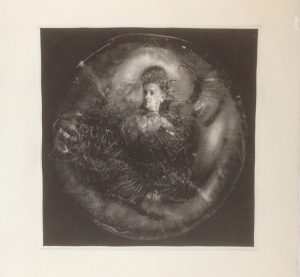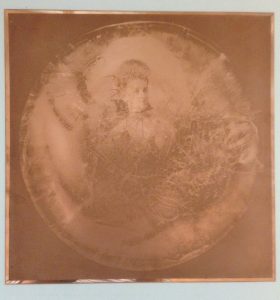![]() Also called dye coupler prints and “type-C prints (if made from a negative) or type-R prints (if made from a transparency),” chromogenic prints form the majority of color prints made after their introduction in 1936 and before advent of digital ink-based printing. The term “chrome” refers to the origin of the photograph in a slide or transparency. Some chromogenic prints produced today are made from scanned slides or transparency that are then printed digitally. Commercially manufactured paper coated with emulsions containing colored dyes enabled photographers to choose from a wide range of surfaces, ranging form matte to ultra-glossy. Easier and less costly to produce than the dye-transfer process, some chromogenic prints lack the color stability of dye-transfer prints or archival digital papers and inks used today and are prone to color fading.
Also called dye coupler prints and “type-C prints (if made from a negative) or type-R prints (if made from a transparency),” chromogenic prints form the majority of color prints made after their introduction in 1936 and before advent of digital ink-based printing. The term “chrome” refers to the origin of the photograph in a slide or transparency. Some chromogenic prints produced today are made from scanned slides or transparency that are then printed digitally. Commercially manufactured paper coated with emulsions containing colored dyes enabled photographers to choose from a wide range of surfaces, ranging form matte to ultra-glossy. Easier and less costly to produce than the dye-transfer process, some chromogenic prints lack the color stability of dye-transfer prints or archival digital papers and inks used today and are prone to color fading.
Category: Uncategorized
What is a photogravure?
 Photogravure is a photomechanical process that combines photography and etching to make ink-based photographic prints. A photograph is etched onto a copper place that is then inked. A dampened sheet of paper is placed on top of the inked plate, which is then run through an etching press. Popular with Pictorialist photographers who wanted to raise the status of photography to fine art at the end of the nineteenth century, in the early twentieth century photogravure was popularized by Alfred Stieglitz, who included finely made photogravures in his publication Camera Work. Unlike photomechanical processes such as half-tone that rely upon dot patterns to reproduce an image, photogravure produces a finely-nuanced continuous tone image. Color effects can be achieved through the use of tinted inks.
Photogravure is a photomechanical process that combines photography and etching to make ink-based photographic prints. A photograph is etched onto a copper place that is then inked. A dampened sheet of paper is placed on top of the inked plate, which is then run through an etching press. Popular with Pictorialist photographers who wanted to raise the status of photography to fine art at the end of the nineteenth century, in the early twentieth century photogravure was popularized by Alfred Stieglitz, who included finely made photogravures in his publication Camera Work. Unlike photomechanical processes such as half-tone that rely upon dot patterns to reproduce an image, photogravure produces a finely-nuanced continuous tone image. Color effects can be achieved through the use of tinted inks.


What is a Photogravure?
![]() Photogravure is a photomechanical process that combines photography and etching to make ink-based photographic prints. A photograph is etched onto a copper place that is then inked. A dampened sheet of paper is placed on top of the inked plate, which is then run through an etching press. Popular with Pictorialist photographers who wanted to raise the status of photography to fine art at the end of the nineteenth century, in the early twentieth century photogravure was popularized by Alfred Stieglitz, who included finely made photogravures in his publication Camera Work. Unlike photomechanical processes such as half-tone that rely upon dot patterns to reproduce an image, photogravure produces a finely-nuanced continuous tone image. Color effects can be achieved through the use of tinted inks.
Photogravure is a photomechanical process that combines photography and etching to make ink-based photographic prints. A photograph is etched onto a copper place that is then inked. A dampened sheet of paper is placed on top of the inked plate, which is then run through an etching press. Popular with Pictorialist photographers who wanted to raise the status of photography to fine art at the end of the nineteenth century, in the early twentieth century photogravure was popularized by Alfred Stieglitz, who included finely made photogravures in his publication Camera Work. Unlike photomechanical processes such as half-tone that rely upon dot patterns to reproduce an image, photogravure produces a finely-nuanced continuous tone image. Color effects can be achieved through the use of tinted inks.

